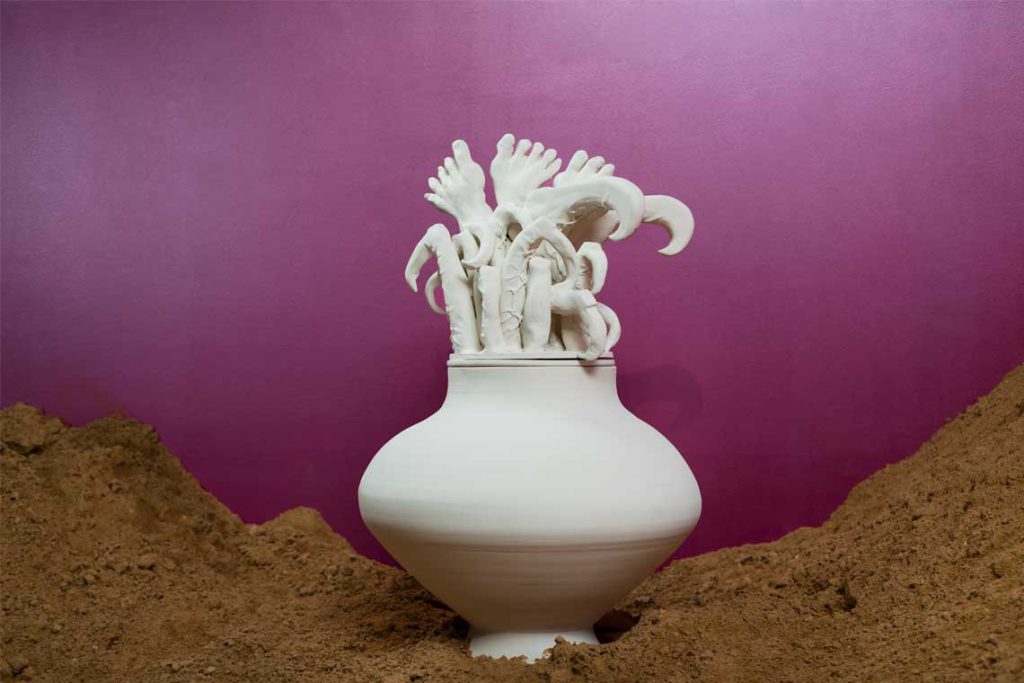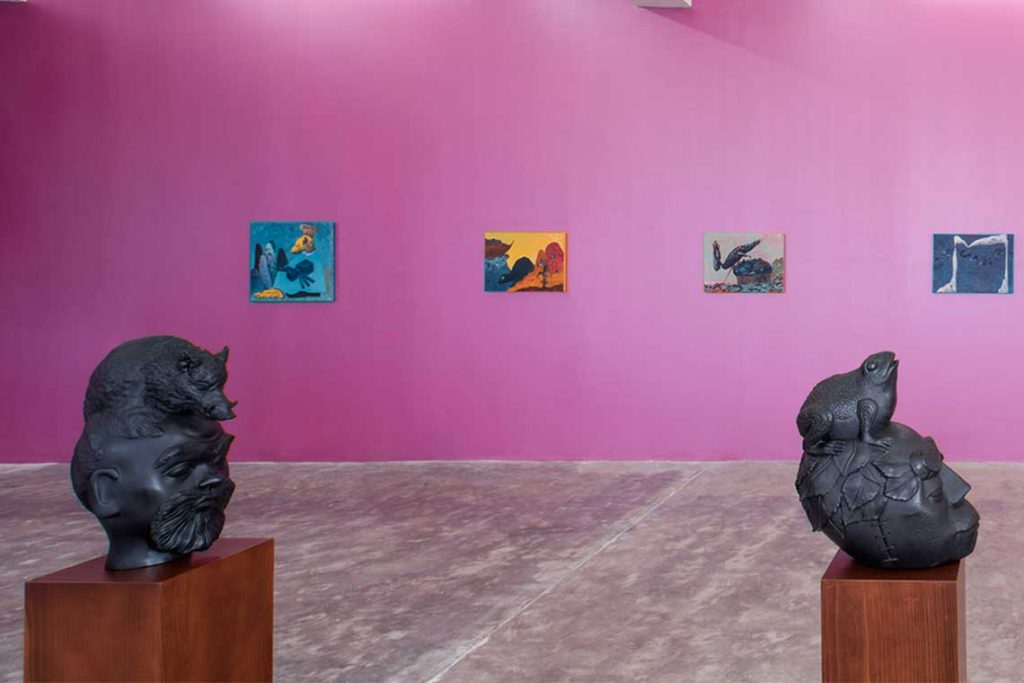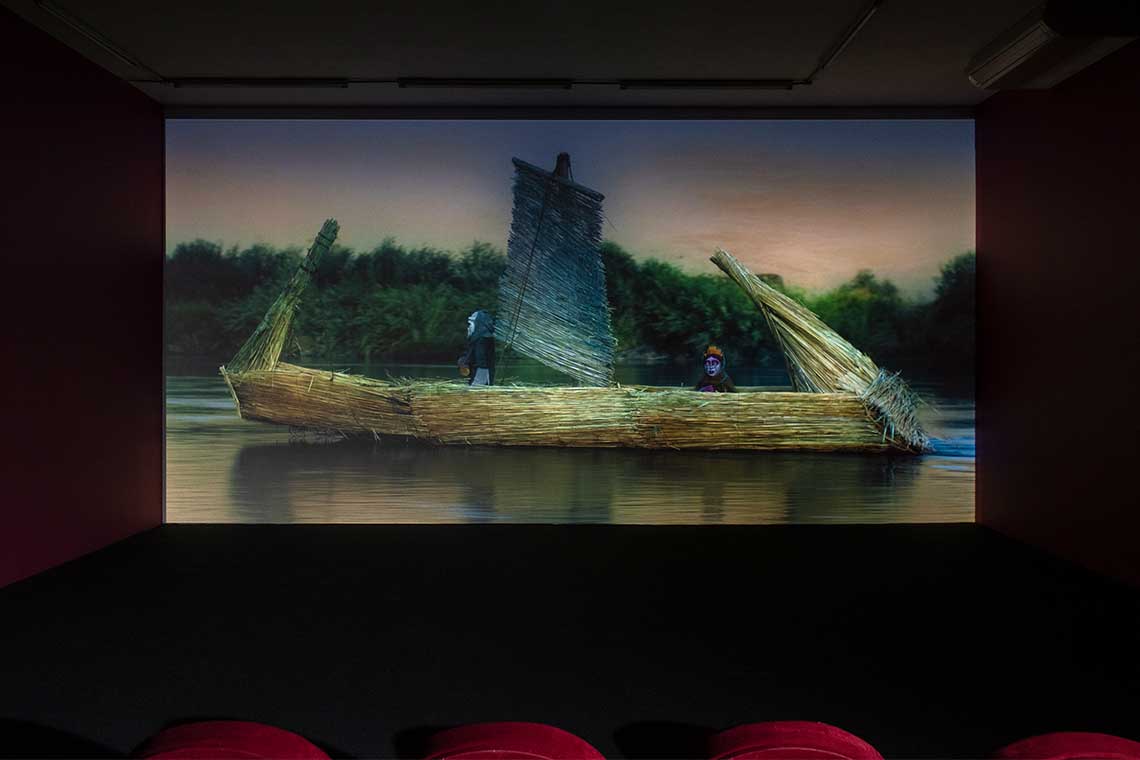The latest show by Wael Shawky at Sfeir-Semler Gallery in Beirut traverses myths, history and storytelling in an odyssey of the imagination.
Ancient civilisations, myths and the transformative nature of stories are themes that Egyptian artist Wael Shawky – who will this year represent Egypt at the Venice Biennale – has explored in different facets throughout his practice, drawing links between our contemporary culture and historical traditions.
His latest solo exhibition I am Hymns of the New Temples, premiering in the MENA region at Beirut’s Sfeir-Semler Gallery, combines his signature research-led and multimedia approach in the presentation of a project rooted in cosmology across different bygone pantheons.
Inspired by ancient Greek, Roman and Egyptian mythology, the exhibition is anchored by an hour-long film – from which the show derives its title – that Shawky first produced for the Pompeii Commitment. Archaeological Matters programme, the contemporary art initiative organised by the Pompeii Archaeological Park (PAP). He won the tender PAC-Plan for Contemporary Art in 2020, supported by the Italian Ministry of Culture and the PAP, and first screened the film in Pompeii in 2023.

Alongside the film, the Beirut exhibition presents sculptures, paintings and an installation, set up almost like a museum showcasing artefacts. The entrance to the show features a large drift of sand, within which is set a ceramic amphora – an ancient vase-like vessel used to transport goods around the Mediterranean – with a wedge of human feet poking out of its top. This piece sets the tone for the rest of the show, inviting viewers to think about how the history of the Mediterranean, connected by trade and therefore fluid in the exchange of culture, religion and stories, has led to an overlap in the myriad narratives of humanity’s genesis.
The film serves as the show’s leitmotif. With the ruins of Pompeii, buried under the ashes of Mount Vesuvius in the disastrous eruption of 79 AD, and parts of the Nile in Upper Egypt acting as its backdrop, Shawky reflects on the transmutation of civilisation from one era to another. As one dynasty falls, another rises, but with each retaining fragments of the ideology and history of its predecessor, often simply rebranding this inheritance as its own, with small changes and adaptations.
Acted out by people wearing decorative ceramic or papier-mâché masks – drawing on old Roman and Greek theatre styles – the film starts with a performance of a tragi-comedy in the ruins of Pompeii’s amphitheatre, narrated in Arabic. The actors represent the vanished denizens of a city influenced by Greek, Roman and Pharaonic worlds, perpetually moving to Shawky’s original music score.
The story told is that of the Egyptian goddess Isis, and how she would later become part of the Greek and Roman pantheons too, her story altered over time. In Egyptian mythology, she was the mother of all and resurrects her husband Osiris after his assassination, representing life in all its forms and believed to help the dead pass on to the afterlife.
Shawky then turns his attention to Greek mythology, in which Zeus overthrows his father Cronus and tasks Prometheus with creating man from mud, with Athena breathing life into the new form. Prometheus would later be eternally punished for giving humanity fire (a symbol of intelligence and civilisation), but Zeus decided to offer his own contribution by deciding to create Pandora, the first human woman and a typical Eve archetype.
When Zeus falls in love with a human woman named Io, the two myths begin to crossover, which is where Shawky’s investigation really begins. In the Greek tale, Hera learns of Zeus’s betrayal and to protect Io from her wrath, Zeus transforms her into a cow. Hera sends a horsefly to torment Io, chasing her across the world until she arrives in Egypt and turns human again, bearing Zeus a child: Osiris.
In ancient Egyptian myth, Osiris was the sibling and consort of Isis – and king of the gods in his own right – but when the Greek and Roman civilisations adapted the story for their own people, the goddess Isis became superimposed with the human Io. In Pompeii, there is even a Roman temple dedicated to Isis. In keeping with Greek tragedy, the film ends with an exodus scene, prophesying the impermanence of society and continued turmoil that humans are destined to experience, as the gods reign above.

Image courtesy of the artist and Sfeir-Semler Gallery Beirut/Hamburg
Along the walls of the exhibition space – painted a rich Pompeiian red – a colour created when gases from Vesuvius reacted with yellow paint in the ancient frescoes – are masks from the film set, allowing visitors to get up close and personal with them. Three black bronze busts, reminiscent of ancient statue heads but styled after a combination of historic cultures, are positioned on pedestals. Each has animals placed on its head (a frog, two birds and a boar), acting as whimsical crowns.
The paintings take on a more surrealist look, depicting imaginary hybrid creatures – their morph-like figures another allusion to the changeability of civilisation and how cultures will borrow and repurpose the same stories in different guises.
Although the three cultures are different, they all tell tales of creation, destruction, godly punishment and justice. Shawky’s message, however, is less concerned with the technicalities of the myths themselves, but rather humanity’s need to puzzle out where we came from, and where we will go next.



